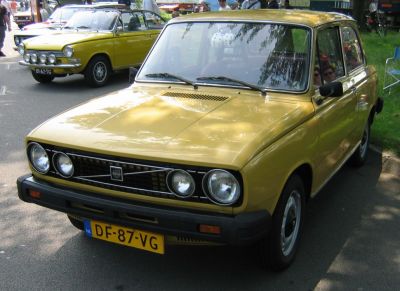 1962 BMW 700 LS Dimensions, Size & Specs
1962 BMW 700 LS Dimensions, Size & SpecsMeasurements of the 1962 BMW 700 LS, engineered for optimal performance and comfort
| Dimensions | |
|---|---|
| Length: | 3860 mm152.0 in12.7 ft |
| Width: | 1480 mm58.3 in4.9 ft |
| Height: | 1360 mm53.5 in4.5 ft |
| Weight Specifications | |
| Curb Weight: | 680 kg1499 lbs |
| Maximal permitted Weight: | 1050 kg2315 lbs |
The BMW 700 LS is a classic compact sedan produced from 1962 to 1965, representing BMW’s early endeavors into small, efficient passenger cars. This generation of the BMW 700 is renowned for its slender and lightweight body, making it a notable model in BMW’s historical lineup. The sedan measures 3860 mm (151.97 inches) in length, 1480 mm (58.27 inches) in width, and 1360 mm (53.54 inches) in height, showcasing a compact profile that was ideal for urban environments and narrow European streets during the 1960s. With a curb weight of just 680 kg (1499 lbs), the BMW 700 LS was built to be agile and economical, offering maximum weight capacity of 1050 kg (2315 lbs) which indicates its ability to comfortably carry passengers and cargo within its size constraints. The 700 LS model is prized for its balance of size and functionality, maintaining BMW’s reputation for driving dynamics even in smaller vehicles. The design and engineering of the BMW 700 LS make it a significant piece of automotive history, exemplifying early post-war automotive trends toward compact, lightweight cars that did not compromise on performance and style.
Discover the standout features that make the 1962 BMW 700 LS a leader in its class
Have a question? Please check our knowledgebase first.
The BMW 700 LS sedan, produced between 1962 and 1965, has compact dimensions characteristic of early 1960s small cars. It measures 3860 mm (151.97 inches) in length, 1480 mm (58.27 inches) in width, and has a height of 1360 mm (53.54 inches). These dimensions reflect the car’s small footprint designed for efficient urban mobility and ease of parking compared to larger sedans of its time. Its narrow width and low height contribute to a streamlined profile, suitable for the modest performance and economical design philosophy behind the BMW 700 series.
The curb weight of the BMW 700 LS is 680 kg (1,499 pounds), which refers to the car’s weight without passengers or cargo but with necessary operating fluids. Its maximum allowable weight, also known as gross vehicle weight, is 1050 kg (2,315 pounds). This relatively lightweight construction helped the BMW 700 LS maintain fuel efficiency and agile handling, key benefits for city driving and early compact cars. The difference of 370 kg (816 pounds) between curb and maximum weight accommodates passengers, luggage, and additional gear within safe operational limits established for the vehicle.
Given its width of 1480 mm (58.27 inches), the BMW 700 LS is indeed narrow enough to fit comfortably in a standard residential garage. Typical garage door widths range from 2400 mm to 3000 mm (approximately 94 to 118 inches), leaving ample clearance on either side for the car to enter and park safely. Its compact length of 3860 mm (151.97 inches) also makes it suitable for standard garage depths, which are usually around 4800 to 6000 mm (189 to 236 inches). Thus, owners of this classic model would generally have no trouble fitting the vehicle in a typical garage space.
The BMW 700 LS was essentially an evolution of the original BMW 700, maintaining similar dimensions but offering improved design refinements. Its length of 3860 mm (151.97 inches), width of 1480 mm (58.27 inches), and height of 1360 mm (53.54 inches) are close to the original 700's measurements, as it was primarily a facelift and slight upgrade rather than a full redesign. The key difference was in styling and trim enhancements rather than significant changes in size or weight. This consistency in dimensions ensured that the 700 LS retained the compact footprint valued by drivers of the earlier model while presenting a more polished and comfortable driving experience.
Compared to other compact sedans of the early 1960s, the BMW 700 LS was relatively petite and lightweight. For instance, a Volkswagen Beetle of the same era measured around 4070 mm (160 inches) in length and weighed approximately 800 kg (1764 pounds), making the BMW 700 LS shorter by over 200 mm and lighter by more than 100 kg. Similarly, the Mini (Austin or Morris) was smaller in length (~3050 mm) but had comparable width and weight. The BMW 700 LS's low weight of 680 kg (1,499 pounds) combined with its narrow and short body made it an agile and economical choice, but with more traditional sedan styling compared to the unconventional shapes of the Beetle and Mini. In summary, it balanced compactness with conventional proportions for its segment.
While exact interior dimensions are less documented for the BMW 700 LS, its compact exterior size inevitably translated into cozy cabin space typical of small sedans of the early 1960s. The limited width of 1480 mm (58.27 inches) meant seating for four adults was snug but feasible, especially since the 700 series was designed as an economical car rather than a spacious luxury vehicle. The trunk space was modest, appropriate for daily errands and small luggage, but not intended for large cargo or heavy family hauling. Generally, the interior prioritized practicality and efficient use of space, providing enough room to comfortably seat four passengers for short to medium trips.
The BMW 700 LS stands at a height of 1360 mm (53.54 inches), which contributes to a relatively low center of gravity for improved stability and handling. While ground clearance specifics are not explicitly documented for this model, given its compact sports sedan profile, the clearance typically would have been modest—likely between 120 mm to 150 mm (4.7 to 5.9 inches). This setup favors nimble handling and a smooth road feel on paved surfaces but means caution is needed over rough terrain or speed bumps. Overall, the low height combined with a lightweight chassis results in agile driving dynamics suited to city and winding country roads typical of the car's era.
At a curb weight of 680 kg (1,499 pounds), the BMW 700 LS benefits from a light overall mass which contributes notably to its nimble and responsive handling characteristics. While specific weight distribution figures are scarce, the BMW 700 series was powered by a rear-mounted engine, influencing a rear-biased weight layout. This setup typically grants improved traction on the driven wheels under acceleration but can introduce oversteer tendencies if not managed properly. The compact size and light weight mean the vehicle responds quickly to steering inputs, making it enjoyable to drive in urban and rural settings, though it requires some skill in managing balance during spirited driving due to its rear-engine layout.
The BMW 700 LS is distinct in its clean, minimalistic design, combining compactness with the characteristic round BMW kidney grilles upfront, which became a hallmark of the brand. Its small size is complemented by subtle chrome trim lines and rounded edges that soften the car’s profile, giving it a more refined appearance than some boxier competitors. The sedan layout features two doors and a relatively low roofline, contributing to a sporty silhouette despite the car’s modest powertrain. Unlike some contemporaries which favored either unconventional shapes or distinctly utilitarian styling, the 700 LS balanced aesthetic appeal with functional design aimed at the economy segment.
The BMW 700 LS is equipped with a rear-mounted, air-cooled, boxer engine which was quite distinctive for BMW at the time. This mechanical layout allows for a compact and simple drivetrain, resulting in efficient use of interior space and a lightweight chassis. The rear-engine configuration provides excellent traction, particularly beneficial on slippery surfaces, though it can cause oversteer during aggressive cornering if not carefully driven. The modest engine displacement and output were designed for economical daily driving rather than outright speed, complementing the car’s small, lightweight build and sporty yet practical hatchback sedan form. This configuration helped define the BMW 700 as a nimble, engaging car for its era.
Discover similar sized cars.

| Production: | 1975-1978 |
|---|---|
| Model Year: | 1975 |
| Length: | 3900 mm153.5 in |
| Width: | 1540 mm60.6 in |
| Height: | 1380 mm54.3 in |
